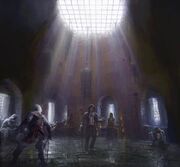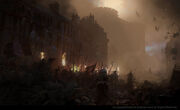No edit summary |
(Adding categories) |
||
| (21 intermediate revisions by 12 users not shown) | |||
| Line 1: | Line 1: | ||
| − | {{Era| |
+ | {{Era|Landmarks}} |
{{WP-REAL}} |
{{WP-REAL}} |
||
| − | {{Spoilerhd}} |
||
{{Stub}} |
{{Stub}} |
||
| + | {{Youmay|the fortress and prison|the [[The Bastille (Server Bridge)|Server Bridge]]}} |
||
| ⚫ | |||
| + | |||
| + | {{Quote|You should feel honored. These days, the Bastille is reserved for madmen, deviants, and traitors.|Bernard Laroche to Arno, 1789.|Assassin's Creed: Unity}} |
||
| + | {{Landmark Infobox |
||
| + | |image = ACU Bastille.jpg |
||
| + | |description = A [[Forts|fortress]] destroyed during the early days of the [[French Revolution]]. |
||
| + | |location = [[Le Marais]], Paris, [[France]] |
||
| + | |dateconstructed = 1370s - 1380s |
||
| + | |functions = Fortress<br> |
||
| + | Prison |
||
| + | |datedestroyed = 1789 - 1790 |
||
| + | |features = [[Viewpoints|Viewpoint]] |
||
| + | |events = [[Storming of the Bastille]]}} |
||
| + | The '''Bastille''' was a [[Forts|fortress]], and later a prison, in [[Paris]], [[France]]. It was [[Storming of the Bastille|stormed]] by a crowd on 14 July 1789, becoming an important symbol for the [[French Revolution]], and was later demolished and replaced by the {{Wiki|Place de la Bastille}}. |
||
| + | |||
| + | ==History== |
||
| + | ===Construction=== |
||
| + | One of King [[Charles V of France|Charles V]]'s many construction projects, the Bastille was built during the [[Hundred Years' War]] to protect the Porte Saint-Antoine gate and its adjoining Saint-Pol palace.<ref name="Unity">''[[Assassin's Creed: Unity]]''</ref> Initial work on the fortress began in 1357 and continued from 1370 on. Although it had been constructed to protect Paris against the [[United Kingdom|English]], it was utilized in internal conflicts as well.<ref name="AE Handbook">[[Assassin's Creed Unity: Abstergo Entertainment - Employee Handbook]]</ref> |
||
| + | |||
| + | ===Transformation into a prison=== |
||
| + | Gradually, the Bastille became less useful as a fortification, its purpose shifting towards that of a prison. It fully embodied this function under the reign of [[Louis XIII of France|Louis XIII]], though the detainees rarely numbered more than 40 each year.<ref name="Unity"/> [[Louis XIV of France|Louis XIV]], also known as the "Sun King", used the fortress to imprison undesirable and inconvenient aristocrats.<ref name="AE Handbook"/> |
||
| + | |||
| + | Under [[Louis XV of France|Louis XV]] and [[Louis XVI of France|Louis XVI]], the prison became more oriented towards equality when it came to the housing of its inmates. Living conditions were reasonably good, especially compared to other prisons of the time. Meals were wholesome, and the Bastille provided medical care for the inmates, including the mentally ill.<ref name="AE Handbook"/> |
||
| + | |||
| + | Still, where commoners would have to do with bare walls and floors, wealthy prisoners were able to bring in luxuries if they so desired. The [[Donatien Alphonse François, Marquis de Sade|Marquis de Sade]], one of the prison's most famous inmates, had tapestries, perfumes, paintings, a full wardrobe and over a hundred books delivered to his cell. Due to his habit of inciting the crowds during his walks, and, later, from the confines of his cell, de Sade was later transferred to another prison.<ref name="AE Handbook"/> |
||
| + | |||
| + | ===Storming of the Bastille=== |
||
| + | {{main|Storming of the Bastille}} |
||
| + | Popular opinion began to turn against the Bastille during the 18th century, with stories and autobiographies from former inmates condemning it. François-Marie Arouet, better known as [[Voltaire]], would refer to the prison as "a palace of revenge". By 1789, it had been deemed useless, as well as costly to maintain, given the 250 [[Guards|soldiers]] it boasted to oversee a mere nine prisoners.<ref name="Unity"/> |
||
| + | |||
| ⚫ | In May of 1789, the [[Assassins|Assassin]] [[Pierre Bellec]] met and started training [[Arno Dorian]], after the latter had been accused of murdering [[François de la Serre]] and imprisoned. Two months later, the two escaped while the prison was under siege by [[French Revolution|revolutionaries]].<ref name="Unity"/> |
||
| + | |||
| + | Arno later infiltrated the Bastille, to recover the famous rope-ladder used by an escapee, [[Jean Henri Latude]].<ref name="Unity"/> |
||
==Trivia== |
==Trivia== |
||
| + | *{{Wiki|Constantin de Renneville}}, a spy for the Dutch incarcerated in the Bastille in the early 1700s, wrote of finding the remains of formers prisoners buried in the floor and walls. |
||
| − | *The developers decided to keep the Bastille intact for the remainder of the game, despite it being demolished fairly early in the story.<ref>[http://www.gametrailers.com/videos/3m61np/assassin-s-creed-unity-recreating-paris GameTrailers: ''Assassin's Creed: Unity'' - Recreating Paris]</ref> |
||
| + | *Despite the fact that, historically, the Bastille had been demolished by 1790, the landmark remained largely intact and could be visited for the remainder of the game. |
||
| + | |||
| + | ==Gallery== |
||
| + | <gallery captionalign="center" position="center" spacing="small" widths="180"> |
||
| + | ACU Bastille Outlook - Concept Art.jpg|Concept art of Paris seen from the battlements of the Bastille |
||
| + | Fall of the Bastille - Concept Art.jpg|Concept art of the Bastille burning in the distance |
||
| + | AC Unity - Concept Art.jpg|Concept art of the Bastille burning in the distance |
||
| + | ACU Prison - Concept Art.jpg|Concept art of one of the Bastille's cells |
||
| + | ACU Civilian Casualties - Concept Art.jpg|Concept art of civilian casualties during the storming of the Bastille |
||
| + | ACU Storming of the Bastille - Concept Art.jpg|Concept art of the Bastille being stormed |
||
| + | ACU Revolutionary Chaos - Concept Art.jpg|Concept art of the Bastille being stormed |
||
| + | </gallery> |
||
==References== |
==References== |
||
{{Reflist}} |
{{Reflist}} |
||
| + | [[pt-br:Bastilha]] |
||
| + | [[ru:Бастилия]] |
||
| + | [[Category:Forts]] |
||
| + | [[Category:Prisons]] |
||
[[Category:Landmarks in Paris]] |
[[Category:Landmarks in Paris]] |
||
| + | [[Category:Viewpoints]] |
||
Revision as of 20:43, 20 June 2019
| This article is about the fortress and prison. You may be looking for the Server Bridge. |
- "You should feel honored. These days, the Bastille is reserved for madmen, deviants, and traitors."
- ―Bernard Laroche to Arno, 1789.[src]
The Bastille was a fortress, and later a prison, in Paris, France. It was stormed by a crowd on 14 July 1789, becoming an important symbol for the French Revolution, and was later demolished and replaced by the Place de la Bastille.
History
Construction
One of King Charles V's many construction projects, the Bastille was built during the Hundred Years' War to protect the Porte Saint-Antoine gate and its adjoining Saint-Pol palace.[1] Initial work on the fortress began in 1357 and continued from 1370 on. Although it had been constructed to protect Paris against the English, it was utilized in internal conflicts as well.[2]
Transformation into a prison
Gradually, the Bastille became less useful as a fortification, its purpose shifting towards that of a prison. It fully embodied this function under the reign of Louis XIII, though the detainees rarely numbered more than 40 each year.[1] Louis XIV, also known as the "Sun King", used the fortress to imprison undesirable and inconvenient aristocrats.[2]
Under Louis XV and Louis XVI, the prison became more oriented towards equality when it came to the housing of its inmates. Living conditions were reasonably good, especially compared to other prisons of the time. Meals were wholesome, and the Bastille provided medical care for the inmates, including the mentally ill.[2]
Still, where commoners would have to do with bare walls and floors, wealthy prisoners were able to bring in luxuries if they so desired. The Marquis de Sade, one of the prison's most famous inmates, had tapestries, perfumes, paintings, a full wardrobe and over a hundred books delivered to his cell. Due to his habit of inciting the crowds during his walks, and, later, from the confines of his cell, de Sade was later transferred to another prison.[2]
Storming of the Bastille
- Main article: Storming of the Bastille
Popular opinion began to turn against the Bastille during the 18th century, with stories and autobiographies from former inmates condemning it. François-Marie Arouet, better known as Voltaire, would refer to the prison as "a palace of revenge". By 1789, it had been deemed useless, as well as costly to maintain, given the 250 soldiers it boasted to oversee a mere nine prisoners.[1]
In May of 1789, the Assassin Pierre Bellec met and started training Arno Dorian, after the latter had been accused of murdering François de la Serre and imprisoned. Two months later, the two escaped while the prison was under siege by revolutionaries.[1]
Arno later infiltrated the Bastille, to recover the famous rope-ladder used by an escapee, Jean Henri Latude.[1]
Trivia
- Constantin de Renneville, a spy for the Dutch incarcerated in the Bastille in the early 1700s, wrote of finding the remains of formers prisoners buried in the floor and walls.
- Despite the fact that, historically, the Bastille had been demolished by 1790, the landmark remained largely intact and could be visited for the remainder of the game.







